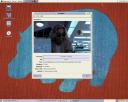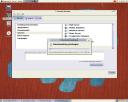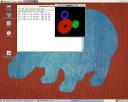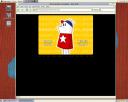Review: BLAG 60001 – Linux Without Boundaries?
May 12, 2007 - Reading time: 19 minutes
BLAG: Linux Without Boundaries?
If you happen to visit the BLAG Linux homepage, one of the first words your eyes will read is “overthrow.” Specifically:
[blag] works to overthrow corporate control of information and technology through community action and spreading Free Software.
Interesting. I’ve tried a lot of Linux distros, but this is the first one whose “anarchistic” intentions are so boldly stated. Alright, perhaps referring to BLAG as “anarchistic” is excessive, so let’s focus on the facts.
What is BLAG?
Made by the Brixton Linux Action Group (hence the name), BLAG is a Linux distro, and not a very popular one at that. It is currently ranked number 79 at Distrowatch, using the “6-month” time-span. More specifically, BLAG is a one-CD distro based on Fedora. The latest version (“60001” – as of this writing) is based on Fedora Core 6. Included on its one CD are numerous applications that a desktop user would “expect” to have.
I first heard about BLAG a few years ago, but did not work up the interest to try it until now. Is its lack of popularity deserved? More importantly, is BLAG worth installing over a more popular distro, such as Fedora, SUSE, or the venerable Ubuntu? Let’s find out.
Hardware
First, some hardware specs. I chose to install BLAG on a rather-antiquated machine. Hey, it still works. No, it probably will not run Vista, but it is happy with Linux.
Motherboard: ECS K7S5A
CPU: AMD Athlon XP 1700 (1.47 GHz)
RAM: 512 MB PC-133
Video Card: Nvidia Geforce 4 MX 420
Sound: Creative Soundblaster “Live”
Monitor: 19″ LCD (1280 x 1024)
Installation
Like Fedora, BLAG uses the Anaconda installer. If you have seen it before, you will feel right at home. As usual, the trickiest part is making sure that you manage your partitions correctly. Also like Fedora, you have the option to verify the integrity of the CD before you begin the installation process. I highly recommend doing this, as my first burn had errors, and the installer dutifully notified me that continuing the installation was risky. Foolishly, I had burned the ISO without verifying the sha1sum, and sure enough, the numbers did not match.
So, I downloaded from a mirror, verified the sha1sum, and proceeded from there. The installation was straightforward, and like with Fedora 6, you have the option to use an “Extras” package repository while installing.
Note: BLAG offers the ability to “nuke” a hard drive and automatically install with the default options, which can be useful for multiple computers or a recycling center. To do so, just type “blagblagblag” at the installation prompt instead of just hitting “enter.” Yes, I tried this, and yes, it works.
First impressions
Upon first boot, I was greeted by what must be the UGLIEST default desktop I have seen in a long time. The default theme is the so-called “blagCanyon” theme, and it was all I could do not to immediately switch to something more aesthetically pleasing, such as “Clearlooks” or at least the old “Bluecurve” theme. Even more appalling is the default wallpaper, which seems to resemble an embroidered hippopotamus. Here it is, in all of its “hippo-beast” glory:
Thankfully, visual elements are easy to change. I am happy that BLAG detected all of my hardware, since I would have ended the review process right there if it had not done so. I fully expect a Linux distro from 2007 to detect all of my hardware from 2002, especially considering that I do not have any peculiar peripherals. BLAG set up a screen resolution of 1280 x 1024, which is the highest resolution my monitor will support. I am pleased that the default fonts look fine as well.
Software
Let’s look at some the software that comes with BLAG. Remember that all of this fits on one CD.
Like Ubuntu, BLAG defaults to the GNOME desktop (2.16.3), which is fine with me. For those interested, Fluxbox is also on the CD. I was pleasantly surprised to see a number of packages installed by default, including:
- Graphics: Blender , Inkscape, and The Gimp
- Internet: Firefox, Thunderbird, Gaim (not yet re-named “Pidgin”), and gFTP
- File sharing: Bittorrent and gtk-gnutella
- Office programs: Abiword, Gnumeric, and Scribus
- Audio/Video: Audacity, Democracy, Grip, gPodder, Listen, Kino (video editor), Istanbul (screencasting), Streamtuner, and Thoggen (DVD Ripper)
As you can see, there are a number of multimedia applications installed by default, which is nice. I ran into a few other pleasant surprises as well. For instance, playback of MP3 files works out of the box, which is rare to find in many Linux distros (due to legal reasons). Also, I popped one of my favorite DVDs into my DVD drive, fully expecting to have to download a few extra packages to enable DVD playback. To my surprise, Xine popped up and began playback immediately. Nice.
Testing my luck, I decided to fire up Thoggen DVD Ripper to see how easy it would be to “rip” my DVD. Once again, the process worked exactly as it should, and within seconds I began the “ripping” process. As you can see from the screenshot, it was going to take my aging computer over seven hours to complete the procedure, so I canceled it. Still, it worked, and it worked the first time for me, which is impressive.
The main software package NOT installed by default is OpenOffice.org. I presume it was omitted due to space considerations on the one CD. Fortunately, it IS available in the software repository. More on that in a moment.
Updating (CLI)
Like Fedora, BLAG is an RPM-based distro, and uses YUM to install and update software. If you have used YUM in Fedora, you already know how it works. In a nutshell, become “root” in the Terminal:
# su –
(enter your root password)
To update the packages on your system, type:
# yum update
To search for a new package (such as “foo”) to install:
# yum search foo
To install a new package (such as “foo”):
# yum install foo
For instance, I decided to install VideoLAN Client. By searching, I discovered that the name of the package in the repository is “vlc.” So, by simply typing:
# yum install vlc
Within a few minutes I had the program installed and running on my system.
Curiously, BLAG also includes a port of Debian’s APT for RPM. If you have used Debian (or Ubuntu), you should be familiar with APT. Both tools accomplish the same goal using seemingly the same repository, so I question the inclusion of both. I remember installing APT and using it almost exclusively on Fedora Core 1, but since it seemed that YUM was to be the official successor, I switched and never looked back.
Out of curiosity, I tried an “apt-get update” and all seemed to work well, so it appears that using both APT and YUM will not leave a smoldering crater where your computer once stood. Given my familiarity with YUM and Fedora, I will continue using YUM for package management.
Updates (GUI)
For you graphical people, you will be pleased to know that BLAG comes with Pirut, a GUI program that allows for the addition and removal of software. Simply go to the “Applications” menu, and choose “Add/Remove Software” to launch it.
With Pirut, you can search through all of the packages in the repository, and choose to install/uninstall at will. For instance, I chose to install OpenOffice through Pirut (see screenshot).
Since BLAG comes with the aforementioned APT, it also contains Synaptic, the graphical counterpart. Like Pirut, you may use Synaptic (under System – Administration) to install/uninstall programs. Once again, I question the inclusion of both update programs. I installed a random program via Synaptic, and all seemed to work well, so there does not seem to be any harm in including both. Your mileage may vary. I’ll stick to YUM and Pirut.
Nvidia
Now that I downloaded some software updates, there was one thing missing: the official Nvidia graphics driver. BLAG set up the 2D-driver just fine, but my poor Geforce 4 could only muster about 220 FPS in “glxgears.” I searched the repository, but did not see the official Nvidia driver listed. So, I decided to download the official Nvidia driver and manually install it. (Note: I do not have any ATI hardware, so I could not try installing the ATI drivers).
This, however, proved far more troublesome than I expected. If you did a default installation of BLAG, you will need to install a few extra packages before you can install the official Nvidia drivers. Using YUM is probably the easiest method. As root, type:
# yum install binutils, make, gcc, kernel-devel
That should fetch a number of files required to build and install the new kernel module. Since my Geforce 4 MX 420 is so old, it is supported by the legacy Nvidia driver. I certainly hope a newer card can be installed more easily. Here is the process that I went through:
1) Download the official Nvidia driver. Remember where you save it.
2) Switch to runlevel 3. One way to do this is to press Control+Alt+Backspace. If the main login window comes up instead of dropping you to a black screen, then log into a “failsafe” terminal session. Become root, and type:
# init 3
3) Now that you are out of the GUI, become root, navigate to your Nvidia driver, and install it like this:
# sh NVIDIA-Linux-[name of file].run
Provided you installed the development tools mentioned above, you should be able to build and install the driver. Hopefully now you can “startx” as a regular user (or simply reboot). If all went well, you should see an “Nvidia” splash screen as your system starts.
In my case, I had more work to do. For starters, my screen resolution had been reduced to 800 x 600. This was easy to fix. Go to “Administration – Display,” switch to the “Hardware” tab, and make sure your monitor type is listed. I chose “LCD Panel 1280 x 1024, fixing my problem.
I also had to edit my X.org file by hand (/etc/X11/xorg.conf), something I have not had to do in quite a while. Here are the edits I had to make:
1) Add a “Module” section to the beginning of the file:
Section “Module”
Load “glx”
EndSection
2) Under the section “Device,” make sure the driver is listed as “nvidia” and not “nv.”
3) Because my card is a “legacy” card, I had to disable the “Composite” option by adding this section to the end of the file:
Section “Extensions”
Option “Composite” “Disable”
EndSection
The end result is that my “glxgears” jumped up to roughly 1,030 FPS. I hope no one else has to go through all of effort. (Please see the BLAG forums if you need support.) Because my card is “legacy” supported, I hesitate to blame BLAG, but I DO wish they made it easier to install the Nvidia driver. I toyed with the idea of adding a Fedora repository (such as Livna) that contained access to the driver, but did not want to risk corrupting anything else on my system. If someone is daring enough to try it, let me know if it works.
Other Thoughts
Given how BLAG already provides MP3 and DVD playback out of the box, I was suprised that they did not include the Flash player by default in Firefox. After my battle installing the Nvidia drivers, I was scared that Flash would prove difficult as well. I was wrong. Simply allowing Firefox to install the Flash player when prompted worked wonders, so now I can enjoy sites like YouTube and Homestarrunner.
Speaking of videos, I liked that Istanbul was installed by default. I decided to try to make a quick screencast. My computer is far too weak to make a 1280 x 1024 screencast, so I just selected part of the screen. Click here to see the resulting screencast, showing the menu structure of BLAG. It’s not much, but I like that the software is installed and working out of the box. Try not to fear the “hippo-beast” snout in the video. [Tip: if you cannot view the video, try watching it with VLC, no matter your operating system. On BLAG, the video works with Firefox using the m-player plugin by default.]
Summary and Conclusions
I admit: I was prepared to dislike BLAG, given its lowly Distrowatch ranking and apparent lack of popularity. With that in mind, I was pleasantly surprised by a number of features, such as the amount of multimedia support.
Pros:
- One-CD install
- MP3 and DVD support without any tinkering
- Sane default choice of included software
- Vast repository of additional software
Not all is rosy in the land of BLAG, though.
Cons:
- Just UGLY by default – down with the “hippo-beast!”
- Difficult to install Nvidia drivers
- Some of the software is outdated. For instance, Firefox (still codenamed “Deer Park” in BLAG) is stuck at 1.5.0.10, and Openoffice is lagging at version 2.0.4. It makes one wonder if the small size of the project makes for slow software updates in the repository.
Instead of ending here, allow me to comment on a few additional aspects. When reviewing a single-CD distro, one cannot help but make comparisons to other Linux distros, such as Ubuntu.
First of all, one area in which I feel that BLAG could improve is with the installer. Many distros (such as Mepis and Ubuntu) are moving toward merging the installer with the “live” CD, creating a hybrid CD that allows one to actually use the OS while installing it. I would like to see BLAG move in this direction while still keeping the “nuke and install” option at the default prompt.
Secondly, if BLAG wants to remain “free” by not including proprietary drivers (such as Nvidia), that is fine, but at least allow for an easier installation. Ubuntu “Feisty Fawn” has really set a good example in this regard, in that they allow for an easy installation by “enabling” access to restricted drivers, but cautioning about the potential risks and lack of official support beforehand.
Additionally, and this is a minor point, if BLAG wants to be taken seriously, they need to clean up certain aberrations on their web site, such as the purposeful alteration of the word “Windows” into “windoz.” Anarchy issues aside, it is an issue of professionalism, and you will not find such immaturities on the main pages of more mainstream distros.
In the end, would I recommend BLAG? Naturally, I am torn on this issue. For someone new to Linux, I do not recommend it, partly because of the Nvidia issue, and partly because of the lack of support in comparison to a more active distro community. Of course, this is not BLAG’s fault, but a newbie seeking help will simply get more help faster in a more populated community. Given time, perhaps this will change.
So, would I recommend BLAG at all? Yes, but only to those with some existing Linux experience. If you have tried many of the major distros and are looking for a distro contained on a single CD, then perhaps BLAG is worth your time. I came from a fair amount of Fedora experience, so BLAG feels comfortable to me. I doubt I will keep it as my default workstation for now, but I will keep my eye on future releases.
One thing is for certain: I will be sure to immediately banish the “hippo-beast” from my sight!
If you enjoyed this article, please consider subscribing to receive regular updates.




